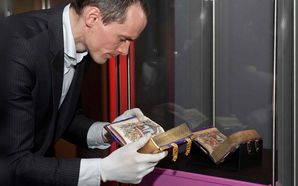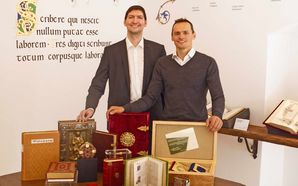The Production of a Facsimile Edition
The realization of every facsimile is a highly complex process. For its successful completion, it is necessary that a large number of specialists and experts in their field work together and bring their experience and expertise to bear. We have put together a short (and very simplified) article for you on how a facsimile is made.
The Selection of the Original Manuscript
At the beginning of a facsimile project there is always the search for an original manuscript from the Middle Ages worthy of creating a facsimile. These rare manuscripts are found in libraries, museums and archives around the world. It is easy to imagine that access to these centuries-old art treasures is very limited and that you must have the necessary qualifications and helpful relationships to have the opportunity to visit one of these unique pieces, which are often valued at millions of euros – not to mention the permission to make a facsimile.
The Phototechnical Record (Digitalization)
Is it possible to find a manuscript that was important in terms of cultural history and art and also dispel the conservative concerns of the responsible committee of curators? Even careful treatment of the original manuscript exposes it to the risk of wear, damage, and even destruction - the next big challenge was to take the photographic data of every detail, which forms the absolute basis for every facsimile. The manuscript must be transferred from the archive with great care to a specially air-conditioned room. All the necessary equipment will then be installed there: a book pad for gentle handling of the original, lighting technology, and of course the special photo-technical device with a high-resolution special camera as the heart. Without going into more detail here, you can already recognize the complex procedure of the necessary digital image acquisition.
The Selection of Paper
In the course of digitization, it is advisable to take a close look at the manuscript: how is the parchment made, is there any damage or wear, what are the exact dimensions? etc. Only then can you get the right materials for the facsimile.
Often facsimiles use a special paper that has been used for the original manuscript (grammage, stiffness, surface quality, etc.). This special paper must of course also meet the most modern quality standards, because the finished work should give you, the collector, many years and decades of pleasure - you and many generations after you!
The Preparation (Pre-Print Stage)
When this process is finally completed, there are hundreds of (sometimes gigabyte-sized) files showing every detail of the original manuscript. These files have to now be prepared individually for printing. The most important of the many steps (and one of the most complex in the entire facsimile process) is the so-called color separation. The spectral images of the original are split up into individual partial images, which only show the amount of color that is required for each run in the million-dollar special printing presses - and for every single page of the original as said before!
The Print
This effort is necessary because every facsimile must be able to look as close as possible to the original manuscript. Unfortunately, this preparation alone is not enough to ensure this goal.
If you have a computer with a printer connected at home, you will have noticed that, for example, a red on the screen does not correspond to the same red on your printouts. A digital image on your screen is a completely different object than an analog printout. In addition, every printer and every printing press has its own peculiarities.
The high-performance printing presses used here also have hundreds of individual settings, which in turn have a direct effect on the resulting print – a highly complex and fault-prone system overall.
Even if you have prepared the print data perfectly and also fine-tuned the printing presses, one effect is unfortunately technically unavoidable: you can only uses a few sheets from the middle of a print run. Both the first prints and the last prints of each run will always deviate from the optimal result: before the perfect color appears, e.g. the yellow is too greenish. Then a few prints with the desired colors follow before the blue, e.g. slides too much into violet. This makes it understandable why tens of thousands of printed sheets have to be destroyed in making a high-quality facsimile because of quality defects!
The true-to-original printing of a facsimile is therefore very time-consuming and cost-intensive and of course still has to be compared with the original on site. This is because only the repeated comparison of the final print result with the original manuscript guarantees the high authenticity of the result.
Gold and Silver Parts
If the print has been completed under ongoing quality inspection, the gold and silver sections must now be printed in a separate process. Special foil printing machines are used for this:
First of all, metal molds have to be produced for each individual page, which was originally embellished with gold and silver. For the production of these metal molds, moreover, complex and templates have to be cumbersomely created by hand, which reproduce the exact locations of the gilding or silver application of the original.
With the help of these metal molds, which are then heated, the gold or silver foils are pressed precisely onto the respective printed sheets. These parts are then aged by hand using various techniques to reproduce the patina of the original.
Trimming
The printed sheets including gold refinement are finally available, but the individual double pages must now be cut out according to the original manuscript.
In order to guarantee the original edge trimming will also be represented in the facsimile, an individual cutting tool must be made for each border (on the outside or holes in the inside of the pages of the original manuscript) - again for each individual page! The templates required for this must also be created for each individual page by hand! After trimming, you finally have individual layers, which in turn must now be sorted according to the original and hand-bound according to the layer scheme on which the original is based.
The Bookbinding
A facsimile must always be bound by hand, as there is currently no machine that can take over this process. There is certainly a lot to be said about the centuries-old job of a master bookbinder, but I would refer you to the relevant specialist literature or to a visit a bookbinding workshop, and I limit myself to mentioning that this manual process is extremely time-consuming and therefore costly.
Mind you: the high-quality materials (wooden covers, threads and special glues according to the original, high-quality embossed leather, often with gold, etc.) are a whole other topic.
Final Remarks
There would certainly be a lot to add that could explain the time and financial expenditure for a facsimile edition (the oft-frustrating difficulties in detail, license fees to the library, the writing of a scholarly commentary, book volumes, etc.). Such a project often takes two years or more, in which a large number of specialists contribute their skills and their entire time. I would just like to address one last point:
The vast majority of facsimiles are unique editions, often limited to just a few hundred copies worldwide! We are not talking about the millions of copies of a popular crime thriller, as sold by normal bookstores, but about the detailed and faithful replica of a medieval art treasure, which become quasi-originals thanks to the enormous use of specialists and materials of the highest quality. Since the high cost of production can only be allocated to a comparatively small number of copies, this explains the price, which seems high compared to "normal" books.
If you finally consider that it can be assumed that a large proportion of facsimile editions are held in the holdings of universities and libraries around the world and that only the rest can be acquired by private collectors, you can judge by the superficial insights into the production of a facsimile listed here what a treasure it is to call a facsimile your own.




